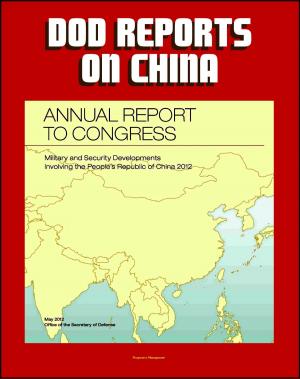Elihu Root Study: The Total Army - United States Army War College Carlisle Scholars Program, 2016 Study on the Future of the United States Army - Strategic Environment, Culture, Command, Agility
Nonfiction, History, Military, Strategy, United States| Author: | Progressive Management | ISBN: | 9781370918164 |
| Publisher: | Progressive Management | Publication: | October 1, 2016 |
| Imprint: | Smashwords Edition | Language: | English |
| Author: | Progressive Management |
| ISBN: | 9781370918164 |
| Publisher: | Progressive Management |
| Publication: | October 1, 2016 |
| Imprint: | Smashwords Edition |
| Language: | English |
This important report has been professionally converted for accurate flowing-text e-book format reproduction. This report is an analysis of the Army conducted by the Carlisle Scholars Program at the U.S. Army War College. Recent studies of the Army have tended to fixate on the mismatch between the ends of national military strategy and the means available to execute it, epitomized by the 2011 Budget Control Act and the 2012 Defense Strategic Guidance. This approach to framing risk is a "short game" that has achieved limited results. This study recommends that the Army reframe its approach. We believe that Army leaders are missing a critical opportunity to use the forcing mechanism of resource constraints to make essential internal changes.
We advocate a "long game": the Army should focus less on communicating the gap between means and ends, and focus more on closing the gap by innovating in ways. Barring a transformative national security event, the study assumes that means—the financial resources and numerical strength authorized for the Army by the Congress—are unlikely to increase over the next decade. Furthermore, the Army influences but does not control the ends to which it is employed by policy makers. The great challenge for the Army is therefore to remain ready to meet the enduring needs of the nation despite constraints that it cannot control. We focus on how the Army can help itself, analyzing the ways by which the Army organizes and prepares itself to meet the nation's varied and unpredictable ends, using the means that it is given.
The Army's ways, as well as its means, affect how it produces options for policy makers. The Army must manage its ways to achieve agility, which is here defined as the ability to provide a wide range of effective options in time to affect the outcome and at the lowest possible cost.
The Army's choices about its ways are shaped by three powerful tensions: a volatile strategic environment that produces unpredictable demands for Army capability; a wide range of legal and institutional requirements that the Army must fulfill, regardless of the security situation; and a deeply-rooted organizational culture that is both an asset and a liability to the Army.
The first chapter analyzes the strategic environment, which will increasingly challenge traditional rules, geographic boundaries and identities.
This important report has been professionally converted for accurate flowing-text e-book format reproduction. This report is an analysis of the Army conducted by the Carlisle Scholars Program at the U.S. Army War College. Recent studies of the Army have tended to fixate on the mismatch between the ends of national military strategy and the means available to execute it, epitomized by the 2011 Budget Control Act and the 2012 Defense Strategic Guidance. This approach to framing risk is a "short game" that has achieved limited results. This study recommends that the Army reframe its approach. We believe that Army leaders are missing a critical opportunity to use the forcing mechanism of resource constraints to make essential internal changes.
We advocate a "long game": the Army should focus less on communicating the gap between means and ends, and focus more on closing the gap by innovating in ways. Barring a transformative national security event, the study assumes that means—the financial resources and numerical strength authorized for the Army by the Congress—are unlikely to increase over the next decade. Furthermore, the Army influences but does not control the ends to which it is employed by policy makers. The great challenge for the Army is therefore to remain ready to meet the enduring needs of the nation despite constraints that it cannot control. We focus on how the Army can help itself, analyzing the ways by which the Army organizes and prepares itself to meet the nation's varied and unpredictable ends, using the means that it is given.
The Army's ways, as well as its means, affect how it produces options for policy makers. The Army must manage its ways to achieve agility, which is here defined as the ability to provide a wide range of effective options in time to affect the outcome and at the lowest possible cost.
The Army's choices about its ways are shaped by three powerful tensions: a volatile strategic environment that produces unpredictable demands for Army capability; a wide range of legal and institutional requirements that the Army must fulfill, regardless of the security situation; and a deeply-rooted organizational culture that is both an asset and a liability to the Army.
The first chapter analyzes the strategic environment, which will increasingly challenge traditional rules, geographic boundaries and identities.















